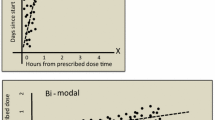Abstract
Three experiments were conducted to evaluate the accuracy of urine ultraviolet fluorescent tests for riboflavin, which has been used as a tracer for medication compliance in several clinical drug trials. Observer accuracy in discriminating riboflavin-positive or negative urine samples was found to vary with the method of observation, dose of riboflavin, observer experience, and time postingestion. The results showed that, while the 5-mg dose used in previous clinical trials was too small to permit reliable assessment of compliance, larger doses of riboflavin could produce nearly 100% accuracy for minimally trained observers who used a matching-to-sample observation procedure. The findings are discussed in terms of the potential clinical and research applications of this type of simple but reliable compliance assessment procedure.
Similar content being viewed by others
References
Cluss, P. A., and Epstein, L. H. (in press). A riboflavin tracer method for at-home asessment of medication compliance in children.Behav. Res. Meth., Treat., Comp.
Cluss, P. A., Epstein, L. H., Galvis, S. A., Fireman, P., and Friday, G. (1984). Effect of compliance for chronic asthmatic children.Consult. Clin. Psych. 52: 909–910.
Deuschle, K. W., Jordahl, C., and Hobby, G. L. (1960). Clinical usefulness or riboflavintagged isoniazid for self-medication in tuberculosis patients.Am. Rev. Resp. Dis. 82: 1–10.
Epstein, L. H., and Cluss, P. A. (1982). A behavioral medicine perspective on adherence to long-term medical regimens.J. Consult. Clin. Psychol. 50: 950–971.
Epstein, L. H., and Masek, B. J. (1978). Behavioral control of medicine compliance.J. Appl. Behav. Anal. 11: 1–9.
Goldman, A. I., Holcomb, R., Perry, H. M., Jr., Schnaper, H. W., Fitz, A. E., and Frohlich, E. D. (1982). Can dropout and other noncompliance be minimized in a clinical trial?Control Clin. Trials 3: 75–89.
Haynes, R. B., Taylor, D. W., and Sackett, D. L. (1979).Compliance in Health Care, Johns Hopkins University Press, Baltimore.
Hobby, G. L., and Deuschle, K. W. (1959). The use of riboflavin as an indicator of isoniazid ingestion in self-medicated patients.Am. Rev. Resp. Dis. 80: 415–423.
McKenney, J. M. (1979). The clinical pharmacy and compliance. In Haynes, R. B., Taylor, D. W., and Sackett, D. L. (eds.),Compliance in Health Care, Johns Hopkins University Press, Baltimore.
Peck, C. L., and King, N. J. (1982). Increasing patient compliance with prescriptions.JAMA 248: 2874–2877.
Steckel, S. B., and Swain, M. A. (1977). Contracting with patients to improve compliance.Hospitals 51: 81–84.
Veterans Administration Cooperative Study Group on Antihypertensive Agents (1970). Effects of treatment on morbidity in hypertension.JAMA 213: 1143–1152.
Veterans Administration Cooperative Study Group on Antihypertensive Agents (1977a). Propanolol in the treatment of essential hypertension.JAMA 237: 2303–2310.
Veterans Administration Cooperative Study Group on Antihypertensive Agents (1977b). Multiclinic controlled trial of bethanidine and guanethidine in severe hypertension.Circulation 55: 519–525.
Author information
Authors and Affiliations
Additional information
This research was supported by the Medical Research Service of the Veterans Administration, Health Services Research and Development Grant Award 4187-003 to John E. Martin.
Rights and permissions
About this article
Cite this article
Dubbert, P.M., King, A., Rapp, S.R. et al. Riboflavin as a tracer of medication compliance. J Behav Med 8, 287–299 (1985). https://doi.org/10.1007/BF00870315
Accepted:
Issue Date:
DOI: https://doi.org/10.1007/BF00870315




